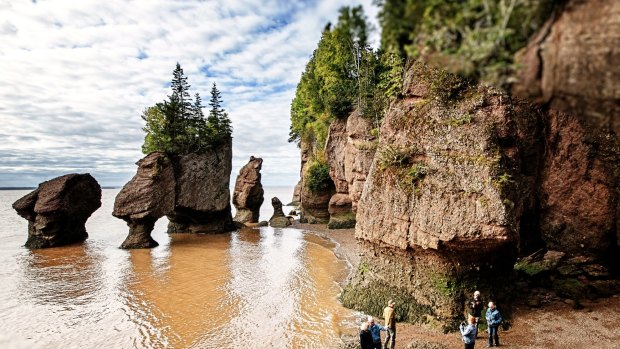This was published 4 years ago
Canada's Bay of Fundy: The crazy phenomena that creates obscenely beautiful landscapes

Hopewell Rocks and Lovers Arch in New Brunswick.Credit: Getty Images
What is it that causes so much natural beauty to be centred in one place?
In the case of the Bay of Fundy, on Canada's east coast, it's wild weather and the highest tides in the world that shape the pristine beaches, dramatic rocky outcrops, waterfalls, cliffs and forests.
This huge body of water separates the Canadian provinces of Nova Scotia and New Brunswick (and touches Maine, the US state), where the majestic, towering cliffs are constantly eroded by gusting winds and ice during winter.
While natural beauty abounds, one of the most amazing discoveries in the area was geological; with erosion revealing an ancient rainforest, more than 300 million years old. There are around 15 kilometres of fossil-bearing cliffs at Joggins, on the Nova Scotian coast, and constant erosion means that every day there is a chance of uncovering something new.
I have no such luck when we take a short tour down to the cliff base on a damp, windy autumn afternoon with the sun desperately struggling to break through.
The cliffs are by no means large, but the jagged, diagonal layers give away their geological importance. I can immediately make out the shape of what seems to be a tree trunk, pointing upright in an opposing direction. Our guide confirms it's one of the fossilised trees, and you can spot many of them right along the cliffs. Trees here are preserved as they grew in the forest. It's the most striking collection of fossils I've ever seen.
And there's more to be found along the rocky surface of the beach, as the entire food chain from the coal age is represented. We see fossilised tracks of ancient amphibians. We'll soon find ourselves swimming alongside them if we don't get a wriggle on, for the Bay of Fundy's crazy tides come full circle every six hours, leaving boats stranded on muddy beaches for miles.
Now that our guide has my full attention, we head back to the Joggins Fossil Centre, which opened in 2007 and explains why Joggins is such an important site. It's the best place on earth to see what life on land was like during the Coal Age and important piece of evidence in Darwin's theory of evolution. A missing link, if you will.
The site was declared a UNESCO World Heritage site in 2008, and was subject to coal mining as far back as the 16th century.
During the Coal Age, huge invertebrates crawled on the ground and giant insects flew in the air. Reptiles and amphibians roamed the wetlands; and you can see fossilised skin from one of these creatures embedded into a rock inside the centre. There's also a fossilised track of a creature that resembled a giant, two metre long millepede (Anthropleura) - made as it crawled through the forest floor 300 million years ago.
On the New Brunswick side, the physical evidence of Fundy's tides has resulted in the spectacular, red-ochre cliffs of Hopewell Rocks, that have been eroded to form almost human head-like shapes, with trees forming a shock of wild hair on top. When the tide's out you can walk along the ocean floor; but when it's in, you can view it's magnificent formations by kayak. The tide here can peak in as fast as 27 minutes, reaching a total height of 46 metres.
What's even more gobsmacking is that the rocks were once part of a massive mountain range, once larger than the Canadian Rockies - and this is all that remains.
It's daunting when our guide reminds us that in time, the Rockies, too, will eventually be eroded away, just like the crumbling cliffs in front of us. I don't think I'll stick around to see that.
TRIP NOTES
FLY
Air Canada fly to Vancouver from Melbourne and Sydney, then on to Montreal, and Halifax; see aircanada.com
TOUR
Atlantic Tours offer fully-guided trips over 13 days to the Canadian Maratimes, encompassing Nova Scotia, New Brunswick and Prince Edward Island. The bus tour includes all accommodation and admission tickets, starting from $4311 per person. See atlantictours.com
Kylie McLaughlin was a guest of Destination Canada and Atlantic Tours & Travel
Sign up for the Traveller Deals newsletter
Get exclusive travel deals delivered straight to your inbox. Sign up now.